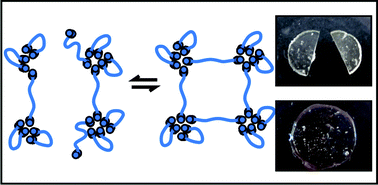Polymers with self-healing or self-repairing properties have gained increasing importance in the past years, often relying on capsule-based concepts, mechanophores and supramolecular concepts. In all cases the basic concept of such materials relies on the use of crosslinking processes which enables repair of a mechanically induced damage by subsequent network-formation. Based on recent observations of hydrogen-bonded supramolecular poly(isobutylene)s (PIBs), where clustering effects were observed due to the interplay of supramolecular association and microphase separation between the polar hydrogen-bonding moieties and the non-polar PIB chains, the authors sought to systematically investigate the clustering and potential use of hydrogen-bonded PIBs for self-healing materials.
Mono- and bifunctional supramolecular PIBs bearing hydrogen-bonding motifs (barbituric acid or a Hamilton wedge) were prepared by a combination of living carbocationic polymerization (LCCP) and azide–alkyne ‘‘click’’ reactions to investigate their dynamics and self-healing behaviour. Temperature-dependent rheology in the melt revealed thermoreversible formation of supramolecular clusters. Stoichiometric mixing of the polymers by solution blending affected the extent of clustering by specifically interacting barbituric acid/Hamilton wedge moieties. Frequency-dependent measurements on bifunctional barbituric acid functionalized PIBs revealed a strong rubbery plateau and terminal flow, caused by the formation of dynamically bridged clusters. Small discs of these polymers showed self-healing at room temperature after being cut and brought into contact at the fractured surface.
Dynamic supramolecular poly(isobutylene)s for self-healing materials by Florian Herbst, Sebastian Seiffert and Wolfgang H. Binder, Polym. Chem., 2012, 3, 3084-3092.
To keep up-to-date with all the latest research, sign up for the journal’s e-alerts or RSS feeds or follow Polymer Chemistry on Twitter or Facebook.











